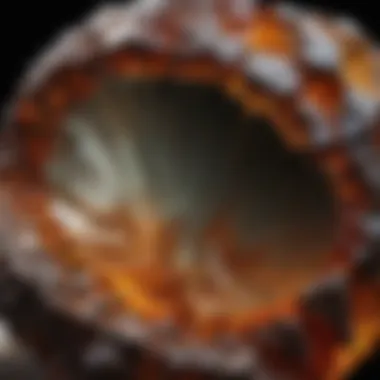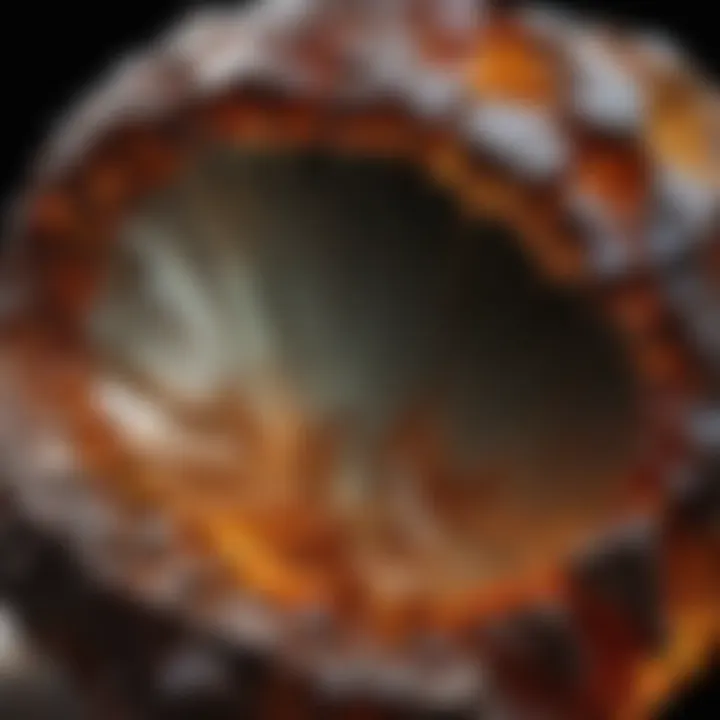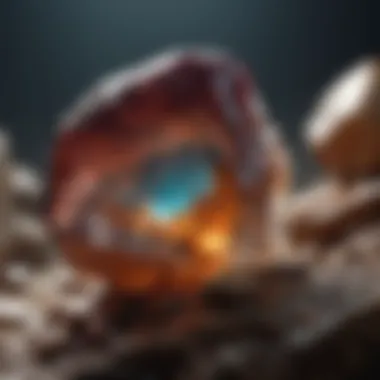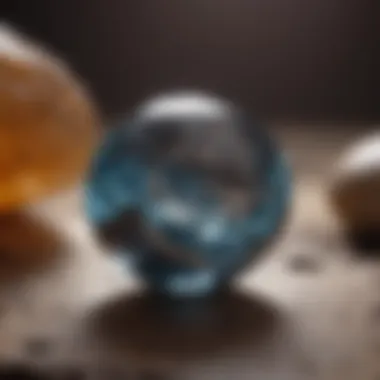The Most Valuable Gem in the World: An In-Depth Analysis


Intro
The world of gemstones is characterized by both beauty and complexity. Among these, one gem stands at the apex in terms of value and significance. This article will explore the intricate factors that contribute to the worth of this remarkable specimen. The journey begins with understanding its history and origins, delving into how geological processes formed it over millions of years.
Furthermore, we will identify the market trends influencing valuation, assess cultural impacts across different societies, and confront the ethical dilemmas related to sourcing and sustainability. By synthesizing these elements, we aim to provide an informative guide for collectors, enthusiasts, and scholars alike.
History and Origins
Geological Formation
Understanding the genesis of the most valuable gem involves examining the geological processes that create gemstones. Many valuable gems, such as diamonds, originate deep within the Earth. High pressure and temperature conditions play a crucial role in their formation. These rare conditions are typically found in areas known as cratons, which are stable portions of the continental crust.
Historical Significance and Cultural Impact
Throughout history, gemstones have been imbued with meaning and value by various cultures. Ancient civilizations, including the Egyptians and Romans, revered certain gems for both their beauty and their supposed metaphysical properties. For instance, the emerald was symbolically linked to fertility and rebirth.
"The power ascribed to gemstones often transcends their physical beauty, shaping their societal roles over time."
Such significance endures today, influencing collector interests and market demands.
Evolution of Value
The value of gemstones has fluctuated throughout history due to various factors, such as supply, demand, and technological advancements in mining and processing. For example, the introduction of synthetic gemstones in the mid-20th century fundamentally altered perceptions of value and authenticity in the market.
Identification and Classification
Guide to Identifying Gems
Identifying high-value gems requires knowledge of their unique properties. Key factors include clarity, color, cut, and carat weight. These elements determine the gem's quality and, consequently, its market price. Being able to distinguish between natural and synthetic stones is often crucial for collectors.
Common Types and Variations
Several prominent and valuable gemstones exist, each with its variations:
- Diamonds: Ranging from colorless to yellow or blue, they are renowned for their brilliance.
- Sapphires: Typically blue but can be found in various colors except red.
- Rubies: Valued for their deep red hue.
Prelude to Gemstones
In the realm of mineralogy and aesthetics, gemstones embody a confluence of beauty and significance. This section provides a foundation for understanding the intricate world of gemstones, especially the most valuable among them. A clear grasp of gemstones begins with their definitions and characteristics, followed by an exploration of their historical valuation. These elements are vital as they offer insights into how and why certain gems hold more value than others.
Definition and Characteristics
Gemstones are defined as precious or semi-precious stones that have been cut and polished, enhancing their natural beauty. The intrinsic qualities that categorize stones as gemstones include their rarity, beauty, and durability. Here are some core characteristics to understand:
- Rarity: The more limited a gemstone is, the more valuable it tends to be. Some gems are scarce due to their unique geological formation, making them highly sought after in the market.
- Beauty: This is often assessed through aspects such as color, brilliance, and clarity. Color can vary widely even within the same species of gemstone, affecting desirability.
- Durability: Gemstones must withstand wear and tear, making hardness an essential characteristic. The Mohs scale quantifies a gemstone's hardness, helping buyers assess how well a stone will hold up over time.
Each characteristic contributes to the overall allure and market value of gemstones, guiding collectors in their quest for unique pieces.
Historical Overview of Gemstone Value
The valuation of gemstones has a rich history that intertwines with human culture and commerce. Historically, gems were symbols of status and power, often used in royal regalia and as trade items.
Long before modern markets, ancient civilizations utilized gemstones for adornment and spiritual significance. For example, the Egyptians cherished turquoise and lapis lazuli, while in India, diamonds gained prominence among the elite. The historical context forms the backdrop for contemporary valuation.
"The earliest recorded use of diamonds was in India around the 4th century BC, where they were valued for their brilliance and toughness."
In more recent times, the establishment of gemological institutions has provided standardized grading systems. The introduction of cut, color, clarity, and carat weight, known as the Four Cs, has refined the commercial landscape of gemstone trading. Not only do these historical insights shape our understanding of gems today, but they also influence how value is determined and perceived in the modern market.
Thus, understanding both the definition and the historical significance of gemstones sets the stage for exploring their valuation in the current context.
Identifying Value: Factors That Determine Gem Quality
Understanding gem quality is crucial for collectors and enthusiasts. The value of a gemstone is determined by a combination of various factors. Recognizing these elements not only helps in evaluating gems but also enhances the overall appreciation of their beauty and rarity. High-quality gems often represent significant investments, making knowledge about their valuation essential.


The Four Cs: Cut, Color, Clarity, and Carat
The Four Cs are fundamental criteria used globally to assess the quality of gemstones. Each element plays an essential role in determining overall value and desirability.
- Cut: The cut of a gemstone affects how light interacts with it. A well-cut gem can enhance its brilliance and sparkle. Various shapes can include round, princess, and emerald. The precision of the cut can lead to better light reflection and, therefore, a higher value.
- Color: Color is often the most noticeable attribute. In gemstones like sapphires and rubies, the richness of color can drastically affect their worth. For instance, a deep blue sapphire is more valuable than a lighter shade. Gemstones are graded on hue, tone, and saturation, and these factors significantly influence their market value.
- Clarity: Clarity refers to the presence of internal or external flaws, known as inclusions and blemishes. A flawless gem is incredibly rare and thus commands a premium price. The clarity scale ranges from included (I1, I2, I3) to flawless (IF). Higher clarity generally correlates with increased value.
- Carat: This measures the weight of the gemstone. Higher carat weight usually means higher value, but this can vary depending on the other Cs. For example, a smaller, higher-quality gem may be worth more than a larger, lower-quality one.
These four aspects must be considered together for a holistic understanding of a gemstone's quality and value.
Additional Considerations: Rarity and Provenance
Beyond the Four Cs, rarity and provenance are significant factors impacting gemstone value.
- Rarity: Availability of a particular gem type influences its market price. For instane, certain colored diamonds are extremely rare. The scarcity of a gemstone makes it more sought after, driving up demand and value.
- Provenance: Provenance refers to the history of ownership and source of a gemstone. Gems with a well-documented history, particularly those connected to notable figures or events, tend to fetch higher prices. A gemstone's origin can also impact its desirability; for example, gems from specific regions known for quality are often more valuable.
In summary, understanding these factors enhances appreciation for gemstones. This knowledge empowers collectors to make informed decisions, whether purchasing for personal enjoyment or as an investment.
"The true value of a gemstone lies within its unique story, transcending mere aesthetics."
Investing time to comprehend these aspects ultimately leads to deeper insights into the world of gemstones.
The Most Valuable Gems in History
The examination of the most valuable gems in history holds a significant place in understanding the broader narrative of gemstones. Each gem often reflects a specific historical narrative and showcases the interplay between cultural significance, economic trends, and rarity. Valuable gems serve not only as objects of beauty but also as symbols of wealth, power, and influence throughout various eras. By delving into notable gems such as the Pink Star, the Hope Diamond, and the Blue Moon Diamond, readers gain insight into how these stones shaped societal views on valuation, investment, and desirability.
The Pink Star Diamond: A Case Study
The Pink Star diamond is a rare and remarkable gemstone that has become synonymous with beauty and value. This stone, weighing in at 59.60 carats, was cut from a pink rough diamond discovered in South Africa in 1999. It is recognized for its vivid pink hue, which is highly sought after in the gemstone market. The unique color is attributed to the presence of lattice defects within the crystal structure, which alters how light interacts with the diamond.
In 2017, the Pink Star was sold for a staggering $71.2 million at auction, setting a record for the highest price ever paid for a gemstone. The auction highlighted the intersection of rarity, desirability, and economic factors influencing the value of gemstones. Its sale value reflects the intense competition among collectors and investors who see these gems as both status symbols and tangible assets.
The Hope Diamond: Myths and Facts
The Hope Diamond carries with it a rich tapestry of myths and legends, contributing to its allure. Weighing 45.52 carats, the deep blue color of this diamond is a result of trace amounts of boron in its structure. This gem has a storied history, often described as one of the most famous cursed objects in the world. Tales of misfortune and tragedy surrounding its previous owners add a layer of intrigue to this already captivating stone.
Originally mined in India, the Hope Diamond has been owned by several notable figures, including King Louis XIV of France. Its journey through history and across various ownerships makes it a fascinating subject of study. Today, it resides in the Smithsonian Institution, where its cultural significance is celebrated alongside scientific examinations of its unique properties, which undoubtedly contribute to its status as a symbol of wealth and historical intrigue.
"The Hope Diamond is not just a beautiful stone; it is a capsule of history that speaks volumes about the human experience of desire and consequence."
The Blue Moon Diamond: Unprecedented Value
The Blue Moon Diamond, with its stunning hue and craftsmanship, has also garnered attention in the world of valuable gems. Weighing 12.03 carats, this fancy vivid blue diamond was discovered in South Africa in 2014. It was noted not only for its exceptional color but also for the meticulous cutting that enhances its brilliance. The stone was sold in 2015 for $48.4 million, which positions it alongside the most expensive diamonds ever sold.
The diamond is remarkable not just for its value but also for its rarity. Fancy blue diamonds account for a tiny fraction of gemstone production, and their appeal among collectors continues to drive their prices higher. The Blue Moon's sale exemplifies the growing trend of investment in unique and high-quality gemstones. Such gems represent not only financial worth but also cultural and historical narratives that captivate gem enthusiasts and collectors.
Understanding the significance of these historical gems provides a richer context for current market dynamics and trends in gemstone valuation. Each gem tells a story that intertwines human ambition, cultural heritage, and the quest for beauty.
Market Trends in Gemstone Valuations
Understanding market trends in gemstone valuations is critical for anyone engaged in the gem trade. The valuation of gemstones is affected by numerous factors, including demand, rarity, cultural significance, and economic conditions. Viewing these dynamics not only provides insights into how gemstones are valued today but also helps predict future market movements. This section will scrutinize current market dynamics and examine economic influences on gem prices, offering a well-rounded perspective for collectors and investors alike.
Current Market Dynamics
The market for gemstones has undergone considerable evolution in recent years. Changes in consumer preferences, technological advancements, and the growing awareness of ethical sourcing have shaped the current landscape. Collectors and investors must pay attention to these elements, as they can significantly impact the perceived value of gemstones.
Some notable trends include:
- Sustainability: There is an increasing preference for ethically sourced gems. Consumers are more informed about the environmental and social implications of their purchases. Rings like lab-grown diamonds are gaining traction among buyers who want to ensure that their investment is ethical.
- Technology Integration: Enhanced technology has made purchasing and evaluating gemstones easier. Online marketplaces now feature vast selections of stones, complete with their certifications and grading, making it less cumbersome for consumers.
- Diverse Preferences: Today’s consumers are increasingly adventurous. Unconventional gemstones such as morganite or tanzanite are popular among modern buyers. This shift expands the range of investment opportunities, as traditional gemstones are no longer the only focus.
The interplay of these dynamics means that gemstone valuations are not static. They evolve in response to larger societal trends and consumer behaviors.
"Market trends often reflect broader cultural shifts. Understanding these shifts can help predict future gem values."
Economic Influences on Gem Prices
The prices of gemstones are also affected by economic conditions, which can be complex and multifaceted. Several factors interplay within this framework, influencing how gems are valued.


- Inflation Rates: General inflation can affect disposable income and thus the demand for luxury purchases like gemstones. When inflation rises, consumers may prioritize essential spending over luxury items.
- Global Economic Climate: A stable economy tends to encourage spending on high-value items. Conversely, during economic downturns, luxury spending often declines, affecting gem prices. Monitoring global markets can provide foresight into potential price changes.
- Currency Exchange Rates: Since gemstones are traded globally, the strength of currency can impact buying power. For instance, a weaker domestic currency may make imported gemstones more expensive, affecting local prices.
- Investment Demand: During uncertain economic times, tangible assets like gemstones often see increased demand as they are viewed as a safe investment. Collectors may turn to gemstones to diversify their portfolios, which can drive prices up.
Cultural Significance of Gems
Gems hold a profound place in human history, serving not only as adornments but also as symbols of wealth, power, and spirituality across various cultures. Their allure transcends mere aesthetics. Understanding the cultural significance of gems provides insight into why society has historically ascribed such high value to these stones. This section delves into how gems like diamonds, sapphires, and rubies intertwine with identity, emotions, and societal constructs.
Gems in Literature and Art
Throughout history, gemstones have inspired countless works of art and literature. Their beauty and rarity lend themselves to metaphorical interpretations in poetry and prose alike. Famous authors such as Shakespeare and writers from the Romantic era frequently referenced gems to convey emotions, status, and moral values.
Art also depicts gems prominently, symbolizing various human conditions. For example, Gustav Klimt's "Portrait of Adele Bloch-Bauer I" incorporates gold and jewels to reflect wealth and femininity. The vividness of gems in visual narratives often suggests deeper meanings, reinforcing their cultural significance.
Some notable examples of gems and their literary references include:
- The Ruby in "The Arabian Nights": Represents love and passion.
- The Emerald in "The Great Gatsby": Signifies wealth and materialism.
These elements show how gems serve as cultural vehicles, transmitting messages and emotions across eras.
Symbolism in Different Cultures
Many cultures attribute specific meanings to various gemstones, which can vary significantly from one region to another. Among the most notable examples:
- Diamonds: Often symbolize purity and eternal love, making them popular in engagement rings in Western cultures.
- Opals: Regarded as tokens of bad luck in some cultures while viewed as symbols of hope in others.
- Jade in Chinese Culture: Considered a stone of protection and purity, jadeite is associated with favor and happiness.
This cultural variability highlights the multifaceted role of gems. They embody more than mere physical properties; they encompass deep-seated cultural values, beliefs, and emotional connections.
Quote: "Gems are not just adornments; they carry stories, meanings, and sentiments spanning generations."
Understanding these cultural significances can enrich one's appreciation for gemstones, particularly for collectors and enthusiasts who seek not only beauty but also history behind their precious acquisitions.
Sourcing and Ethical Considerations
The significance of sourcing and ethical considerations in the gemstone industry has come to the forefront of discussions surrounding ethical consumerism and sustainability. As the demand for gemstones continues to rise, it is crucial to ensure that the methods used in their procurement do not contribute to social and environmental harm. This section evaluates conflict diamonds and sustainable mining practices, shedding light on the broader implications of gemstone acquisition.
Conflict Diamonds: An Ongoing Issue
Conflict diamonds, often referred to as "blood diamonds," are gemstones mined in war zones and sold to finance armed conflict against governments. The sale of these diamonds has fueled violence and human rights abuses, particularly in African nations like Sierra Leone and the Democratic Republic of Congo. The role of conflict diamonds in sustaining wars has led to increased scrutiny from international organizations and the public.
In response to these concerns, initiatives like the Kimberley Process Certification Scheme were established to prevent the trade of conflict diamonds. While the process has made strides in standardizing the sourcing of diamonds, critics argue that it is not sufficient. The effectiveness of the scheme is often undermined by weak enforcement mechanisms and the ability of unscrupulous entities to circumvent regulations. As such, buyers must be vigilant and require transparency from their gemstone suppliers to avoid supporting unethical practices.
Sustainable Mining Practices
Sustainable mining practices offer a way to mitigate the negative impacts associated with gemstone extraction. These practices focus on reducing environmental damage, ensuring fair labor conditions, and supporting the local communities where mining takes place. Some key elements include:
- Environmental Management: Responsible mining operations take steps to minimize land degradation and water pollution. Companies employ techniques that rehabilitate mining sites once extraction is complete, which can help restore ecosystems.
- Fair Labor Standards: Ethical sourcing means ensuring that workers are treated fairly and paid equitable wages. Sustainable practices advocate for the elimination of child labor and unsafe working conditions, promoting respect for human rights.
- Community Engagement: Mining companies are increasingly required to engage with local communities to ensure that their needs are addressed. This includes providing employment opportunities and investing in local infrastructure, such as schools and healthcare facilities.
Implementing sustainable mining practices not only helps to protect the environment but also enhances the reputation of the gemstone industry.
"The gemstone industry must evolve to meet the ethical demands of consumers and investors alike."
As investment in gemstones grows, so does the responsibility that comes with it. To that end, both consumers and suppliers must advocate for reform and hold themselves to higher ethical standards. By considering where and how gemstones are sourced, the market can more sustainably evolve.
Technological Advances in Gemology
Technological advances in gemology fundamentally transform how we understand and evaluate gemstones. In an age where precision meets artistry, these innovations provide deeper insights into gem characteristics and authenticity. Understanding these developments is crucial for both collectors and investors in this field.
Innovations in Gemstone Identification
One of the most significant advancements in gemology is the technology used for identifying and grading gemstones. Instruments such as laser spectroscopy and photoluminescence imaging allow gemologists to analyze a stone's internal structure with remarkable accuracy. This precision helps to determine a gem's origin and any treatments it may have undergone, such as heating or dyeing. Collectors can now verify the legitimacy of their stones more easily.
Examples of some key tools include:
- Desktop spectrometers: Used for analyzing light interactions within a gemstone.
- Gem microscopes: Facilitate high-resolution examination of inclusions and surface characteristics.
- Refractometers: Measure a gemstone's refractive index, which helps in differentiating between similar-looking gems.
These tools have made a significant impact on the market, ensuring quality and transparency. Therefore, buyers can invest in gemstones with more confidence.


Impact of Lab-Grown Gems on Market Dynamics
Lab-grown gemstones are reshaping market dynamics by introducing affordability and accessibility into the gem industry. They are chemically identical to their natural counterparts and often produced with greater precision. As consumers become more sustainability-minded, the demand for lab-grown gems is increasing. This shift changes how collectors view value and rarity in gemstones.
Some important considerations include:
- Price differences: Lab-grown gems can be 30-40% cheaper than natural stones, providing budget-friendly options for buyers.
- Sustainability: Concerns regarding mining practices have made lab-grown alternatives appealing to environmentally conscious consumers.
- Market differentiation: As lab-grown gems gain popularity, natural gemstones may evolve into luxury items, impacting their scarcity and value perception.
Overall, these changes underscore the importance of staying informed about market trends in gemology. Collectors must navigate this evolving landscape to enhance their portfolios and knowledge.
Investment Opportunities in Gemstones
Investment in gemstones presents a unique avenue for those looking to diversify their portfolios. The allure of jewels is not only in their beauty but also in their potential for value retention and appreciation over time. As individuals increasingly seek alternatives to traditional investment vehicles, gemstones, with their intrinsic value and rarity, become attractive assets worthy of examination.
Value Retention and Appreciation
One of the most significant attributes of gemstones is their ability to retain value. Unlike common consumer goods that depreciate after purchase, high-quality gemstones often appreciate significantly, even in uncertain economic times. Historical data shows that certain gemstones, especially rare varieties like diamonds and emeralds, have consistently outperformed other investment options.
Several factors contribute to this value retention. For instance, the rarity of a gemstone plays a crucial role. The pink diamonds, for example, are exceptionally rare and their prices have surged in recent years, making them a sound investment choice. Additionally, the market demand, fueled by collectors and investors alike, further propels the prices upwards.
"Investors should carefully select gemstones for investment based on quality and potential for demand."
Diversifying Investment Portfolios with Gems
Incorporating gemstones into an investment strategy is a prudent method for wealth diversification. Traditional stocks and bonds can be volatile, while gemstones often provide a more stable investment option. This is particularly true for investors looking to hedge against inflation or economic downturns.
When considering gems for portfolio diversification, investors should keep several elements in mind:
- Quality and Certification: Always obtain gemstones that have been certified by a reputable gemological laboratory. This ensures authenticity and value.
- Market Trends: Stay informed about trends in the gemstone market. The value of specific types can fluctuate based on fashion trends, economic factors, and cultural influences.
- Long-Term Outlook: Remember that the best returns often come from a long-term investment perspective. Unlike stocks, which might offer quick returns, gemstones often require time to appreciate fully.
Finally, consider exploring various types of gemstones, not just the most popular. This approach not only expands investment opportunities but also spreads risk. For example, lesser-known gems like alexandrite or tanzanite may yield substantial returns if market interest increases.
The Future of Gemstone Valuations
The understanding of gemstone valuations is evolving rapidly. As we look to the future, multiple factors are influencing how these valuable assets are perceived and traded. The dynamic interplay between economic trends, technological advancements, and consumer preferences shapes the landscape of gem valuations.
Impact of Economic Trends
Economic trends significantly influence gemstone values. Several factors play a role, including global financial stability, inflation rates, and shifts in consumer spending. Historically, gemstones are considered a hedge against inflation. When traditional investments falter, affluent individuals often turn to tangible assets like gems, driving up their value.
In addition, international trade agreements and tariffs can affect gemstone import costs and, consequently, market prices. For example, any shifts in trade policies between major producing countries like South Africa or Russia can lead to fluctuations in gemstone prices worldwide. Moreover, the rise of new economies introduces new buyers with unique preferences, further shifting market demand.
"Understanding the interplay between economic indicators and gemstone valuations can help collectors make informed decisions about investments."
The Role of Digital Marketplaces
Digital marketplaces are changing the way gemstones are bought and sold. Platforms such as Etsy or eBay have opened global access for sellers and buyers. This transition allows collectors to reach a wider audience, which can lead to increased competition and potentially higher prices.
Moreover, advancements in technology have led to the creation of specialized online platforms like GemRockAuctions or James Allen, enabling customers to compare gem qualities and prices seamlessly. Virtual auctions and live bidding have become more common, making it easier for serious collectors to acquire rare gems.
However, this shift to online marketplaces also raises concerns about authenticity and misrepresentation. Buyers must rely on reputable dealers and certification processes. Ensuring transparency through ethical sourcing and certification will be crucial for maintaining trust in digital transactions. As these platforms evolve, they will likely play an increasingly significant role in determining gemstone valuations moving forward.
Finale: Assessing the Most Valuable Gem
In the realm of gemstones, the concluding section holds significant weight. It serves to encapsulate the various intricate layers explored throughout this article. Understanding what ultimately constitutes the most valuable gem requires both a critical eye and a nuanced perspective on several overarching themes. This includes an analysis of geological attributes, market trends, cultural values, and ethical sourcing, all of which impact a gem's worth.
The importance of this topic lies in the synthesis of these elements. It facilitates a deeper comprehension among collectors and enthusiasts of what truly elevates certain gemstones in value and desirability. By reflecting on these matters, one gains insight not just on monetary worth but on the gems' broader implications in both a social and economic context.
Summary of Key Points
The key points highlighted in this exploration can be summarized as follows:
- Defining Value: The Four Cs—Cut, Color, Clarity, and Carat—play a central role in determining a gem's quality and worth.
- Market Dynamics: Current economic influences and market trends greatly affect gemstone valuation.
- Cultural Significance: The symbolic meanings ascribed to various gems contribute to their desirability and market appeal.
- Ethical Sourcing: The ongoing issues surrounding conflict diamonds and the push for sustainable practices highlight the ethical considerations in gem mining.
- Innovation in Technology: Advances in gemology and the rise of lab-grown alternatives continue to shape the future of gemstones.
"Gem valuation is an ongoing conversation that reveals much about our changing values and priorities as a society."
Final Thoughts on Future Trends
As we glance toward the future of gemstone valuations, certain trends emerge that warrant consideration. Economic fluctuations will likely play a continued role in shaping market dynamics. The increasing integration of digital marketplaces into gemstone buying and selling presents both challenges and opportunities for collectors. With sustainability being at the forefront of consumer concerns, demand for ethically sourced gems will become more pronounced.
Additionally, the innovation in lab-grown gems raises questions about traditional valuation metrics. Their emergence offers potential for disruption in the market, leading to a reevaluation of what constitutes value in gemstones. Thus, keeping an eye on these evolving trends is crucial for those vested in the world of gemstones.



